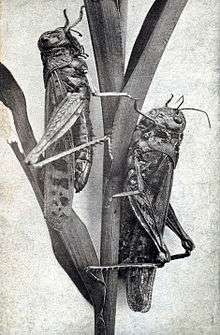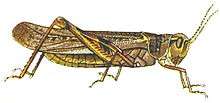Rocky Mountain locust
| Rocky Mountain locust | |
|---|---|
 | |
| Photo from the 1870s | |
| Scientific classification | |
| Kingdom: | Animalia |
| Phylum: | Arthropoda |
| Class: | Insecta |
| Order: | Orthoptera |
| Suborder: | Caelifera |
| Superfamily: | Acridoidea |
| Family: | Acrididae |
| Subfamily: | Melanoplinae |
| Genus: | Melanoplus |
| Species: | †M. spretus |
| Binomial name | |
| †Melanoplus spretus Walsh, 1866 | |
The Rocky Mountain locust (Melanoplus spretus) is an extinct species of locust that ranged through the western half of the United States and some western portions of Canada until the end of the 19th century. Sightings often placed their swarms in numbers far larger than any other locust species, with one famed sighting in 1875 estimated at 198,000 square miles (510,000 km2) in size (greater than the area of California), weighing 27.5 million tons, and consisting of some 12.5 trillion insects – the greatest concentration of animals ever speculatively guessed, according to Guinness World Records.[2]
Less than 30 years later, the species was apparently extinct. The last recorded sighting of a live specimen was in 1902 in southern Canada.[3] Because a creature so ubiquitous was not expected to become extinct, very few samples were ever collected (though a few preserved remains have been found in Grasshopper Glacier, Montana). North America is the only continent without a major locust species, apart from Antarctica.
Distribution


The Rocky Mountain locust largely lived in prairie areas, though they existed on both sides of the Rocky Mountains. Breeding in sandy areas and thriving in hot and dry conditions, they were often guaranteed a good food supply by prairie plants which concentrate sugars in their stalks in times of drought. Movement of the locusts was probably assisted by a low-level jet stream that persists through much of central North America.
Extinction
Rocky Mountain locusts had reportedly plagued farmers in California as early as 1722; they had caused farm damage in Maine in 1743–56 and Vermont in 1797–98.[4] The locusts became more of a problem in the 19th century, as farming expanded westward into the grasshoppers' favored habitat: outbreaks of varying severity emerged in 1828, 1838, 1846, and 1855, affecting areas throughout the West. Plagues visited Minnesota in 1856–57 and again in 1865, and Nebraska suffered repeated infestations between 1856 and 1874.[4]
The last major swarms of Rocky Mountain locust were between 1873 and 1877, when the locust caused $200 million in crop damage in Colorado, Kansas, Minnesota, Missouri, Nebraska, and other states. One farmer reported that the locusts seemed "like a great white cloud, like a snowstorm, blocking out the sun like vapor".[4] The locusts ate not only the grass and valuable crops, but also leather, wood, sheep's wool, and in extreme cases, even clothes off peoples' backs. As the swarms got worse, farmers attempted to control them using gunpowder, fires (sometimes dug in trenches to burn as many of the locusts as possible), smearing them with "hopperdozers", even sucking them into vacuum cleaner-like contraptions, but all of these were ultimately ineffective in stopping the hordes. Charles Valentine Riley, a Missouri entomologist, came up with a recipe for locusts seasoned with salt and pepper and pan-fried in butter. The recipe sold, but some stated that they "would just as soon starve as eat those horrible creatures".[4] Farmers finally responded in force to the swarm's destruction; an 1877 Nebraska law said that anyone between the ages of 16 and 60 had to work at least two days eliminating locusts at hatching time or face a $10 fine. That same year Missouri offered a bounty of $1 a bushel for locusts collected in March, 50 cents a bushel in April, a quarter in May and a dime in June. Other Great Plains states made similar bounty offers. In the 1880s farmers had recovered sufficiently from their locust woes to be able to send carloads of corn to flood victims in Ohio. They also switched to such resilient crops as winter wheat, which matured in the early summer, before locusts were able to migrate. These new agricultural practices effectively reduced the threat of locusts and greatly contributed to the species' downfall.[4]
The cause of their extinction was probably the plowing and irrigation by settlers that disrupted the natural life cycle of the insects in the very small areas where they lived in between swarms.[5] Reports from this era suggest that farmers killed over 150 egg cases per square inch while plowing, harrowing or flooding.[5]:11–12
Because locusts are a form of grasshopper that appear when grasshopper populations reach high densities, it was theorized that M. spretus might not be extinct, that "solitary phase" individuals of a migratory grasshopper might be able to turn into the Rocky Mountain locust given the right conditions; however, breeding experiments using many grasshopper species in high-density environments failed to invoke the famous insect. Analysis of mitochondrial DNA from museum specimens and related species suggests that the Rocky Mountain locust was a distinct and now extinct species, possibly closely related to the Bruner spurthroat grasshopper (Melanoplus bruneri).[6]
The species was formally declared extinct by the IUCN in 2014.[1]
In literature
A fictionalized description of the devastation created by Rocky Mountain locusts in the 1870s can be found in the 1937 novel On the Banks of Plum Creek by Laura Ingalls Wilder. Her description was based on actual incidents in western Minnesota during the summers of 1874 and 1875 as the locusts destroyed her family's wheat crop.[7]
Another vivid portrayal of the depredations of the locust can be found in Ole Edvart Rølvaag's Giants in the Earth, based in part on his own experiences and those of his wife's family.[8]
See also
References
- Footnotes
- 1 2 Hochkirch, A. (2014). "Melanoplus spretus". IUCN Red List of Threatened Species. Version 2014.3. International Union for Conservation of Nature. Retrieved 2014-12-31.
- ↑ "Melanoplus spretus, Rocky Mountain grasshopper". Animal Diversity Web. University of Michigan Museum of Zoology. Retrieved 2009-04-16.
- ↑ Canada's History, October–November 2015, pages 43-44
- 1 2 3 4 5 Lyons, Chuck (5 February 2012). "1874: The Year of the Locust". HistoryNet. Retrieved 2015-06-17.
- 1 2 Lockwood, Jeffrey A. (2004). Locust: the Devastating Rise and Mysterious Disappearance of the Insect that Shaped the American Frontier (1st ed.). New York: Basic Books. ISBN 0-7382-0894-9.
- ↑ Chapco, W.; Litzenberger, G. (March 2004). "A DNA investigation into the mysterious disappearance of the Rocky Mountain grasshopper, mega-pest of the 1800s". Molecular Phylogenetics and Evolution. 30 (3): 810–814. doi:10.1016/S1055-7903(03)00209-4.
- ↑ Yoon, Carol Kaesuk (23 April 2002). "Looking Back at the Days of the Locust". The New York Times. Retrieved 2015-04-01.
- ↑ Curley, Edwin A. (2006) [1875]. "Introduction". Nebraska 1875: Its Advantages, Resources, and Drawbacks. Introduction by Richard Edwards. U of Nebraska Press. p. xvii. ISBN 0-8032-6468-2.
- General references
- Ryckman, Lisa Levitt (22 June 1999). "The Great Locust Mystery". Denver Rocky Mountain News. Retrieved 2013-03-31.
- Samways, M.J.; Lockwood, J.A. (1 January 1998). "Orthoptera conservation: pests and paradoxes". Journal of Insect Conservation. 2 (3/4): 143–149. doi:10.1023/A:1009652016332.
External links
| Wikimedia Commons has media related to Melanoplus spretus. |
